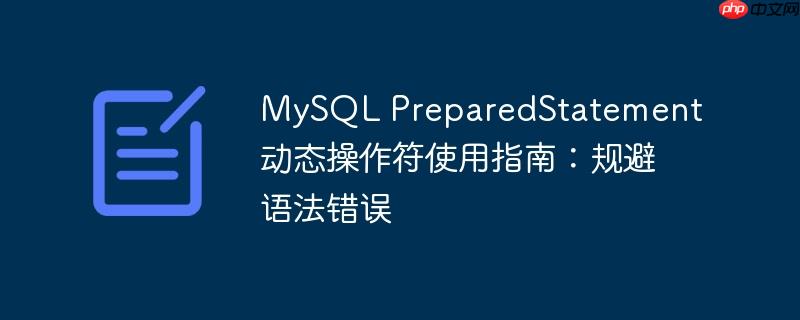
java.sql.PreparedStatement是JDBC中用于执行预编译SQL语句的对象。它通过使用问号(?)作为占位符来接收动态参数,从而提高执行效率并有效防止SQL注入攻击。然而,这些占位符的设计初衷仅限于替换SQL语句中的值(例如,WHERE id = ? 中的?代表一个整数ID,INSERT INTO users VALUES (?, ?) 中的?代表字符串或数字)。
当尝试将操作符(如>, <, =, >=, <=)或SQL关键字、表名、列名等作为参数绑定到?时,数据库驱动程序会将其视为一个字符串字面量,而非预期的SQL语法元素。例如,语句SELECT * FROM total WHERE totals ? ?;在执行时,数据库会尝试将第一个?绑定的字符串(如">=")解析为totals ">=",这显然不是有效的SQL语法,因此会抛出MySQLSyntaxErrorException。
要解决此问题,我们需要将动态的操作符直接拼接进SQL查询字符串中,而将需要比较的实际值继续使用PreparedStatement的参数绑定机制。
以下是修正后的代码示例:
import java.sql.Connection;
import java.sql.DriverManager;
import java.sql.PreparedStatement;
import java.sql.ResultSet;
import java.sql.SQLException;
public class DynamicQueryExample {
public static ResultSet executeDynamicQuery(int type, String amount) throws SQLException, ClassNotFoundException {
Connection con = null;
PreparedStatement stmt = null;
ResultSet rs = null;
try {
Class.forName("com.mysql.jdbc.Driver");
con = DriverManager.getConnection("jdbc:mysql://localhost:3306/jsupermarket", "root", "");
String signString = "";
if (type == 1) { // greater than or equal
signString = ">=";
System.out.print("Type 1 selected (>=)\n");
} else if (type == 2) { // less than or equal
signString = "<=";
System.out.print("Type 2 selected (<=)\n");
} else if (type == 3) { // equal
signString = "=";
System.out.print("Type 3 selected (=)\n");
} else {
// 处理无效类型或提供默认值
throw new IllegalArgumentException("Invalid query type provided.");
}
// 正确的做法:将操作符直接拼接进SQL字符串,而值使用占位符
// 注意:SQL语句末尾不应有分号,JDBC驱动会自动处理
String sql = "SELECT * FROM total WHERE totals " + signString + " ?";
stmt = con.prepareStatement(sql);
stmt.setString(1, amount); // 绑定实际的比较值
rs = stmt.executeQuery();
return rs;
} finally {
// 在生产环境中,务必确保资源(ResultSet, PreparedStatement, Connection)得到正确关闭
// if (rs != null) { try { rs.close(); } catch (SQLException ignore) {} }
// if (stmt != null) { try { stmt.close(); } catch (SQLException ignore) {} }
// if (con != null) { try { con.close(); } catch (SQLException ignore) {} }
}
}
public static void main(String[] args) {
try {
// 示例调用
System.out.println("Querying for totals >= 100:");
ResultSet result1 = executeDynamicQuery(1, "100"); // totals >= 100
while (result1.next()) {
System.out.println("Total: " + result1.getString("totals"));
}
// 实际应用中,处理完ResultSet后应立即关闭
if (result1 != null) result1.close();
System.out.println("\nQuerying for totals <= 50:");
ResultSet result2 = executeDynamicQuery(2, "50"); // totals <= 50
while (result2.next()) {
System.out.println("Total: " + result2.getString("totals"));
}
if (result2 != null) result2.close();
} catch (SQLException | ClassNotFoundException e) {
e.printStackTrace();
}
}
}关键改动点:
通常情况下,将用户输入直接拼接到SQL查询字符串中是非常危险的行为,因为它会引入SQL注入漏洞。例如,如果amount参数直接来自用户输入,并且用户输入了' OR '1'='1,那么原始的查询可能会变成:
SELECT * FROM total WHERE totals = '' OR '1'='1'
这将导致查询返回所有记录,而不是预期的结果。
然而,在当前案例中,signString的值是完全由程序内部逻辑(type变量)控制的,而不是来自外部用户输入。这意味着恶意用户无法通过操纵signString来注入恶意的SQL代码。因此,在这种特定场景下,通过字符串拼接来构建动态操作符是安全的。
最佳实践:
MySQLSyntaxErrorException在PreparedStatement中尝试绑定操作符是常见的误区。核心原因在于PreparedStatement的占位符(?)仅用于绑定SQL语句中的值。解决此问题的方法是将动态操作符通过字符串拼接的方式构建到SQL语句中,同时继续利用PreparedStatement对实际的比较值进行参数绑定。尽管涉及到字符串拼接,但由于操作符源自程序内部控制,此方法在此特定场景下是安全的,并有效规避了SQL语法错误,同时保持了对值绑定的安全性。
以上就是MySQL PreparedStatement动态操作符使用指南:规避语法错误的详细内容,更多请关注php中文网其它相关文章!

每个人都需要一台速度更快、更稳定的 PC。随着时间的推移,垃圾文件、旧注册表数据和不必要的后台进程会占用资源并降低性能。幸运的是,许多工具可以让 Windows 保持平稳运行。

Copyright 2014-2025 https://www.php.cn/ All Rights Reserved | php.cn | 湘ICP备2023035733号